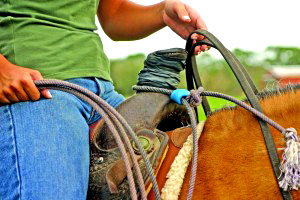By AQHA Professional Horseman Jay Holmes with Christine Hamilton
in The American Quarter Horse Journal
“People who don’t rope a lot are better off tying-on in the heeling,” Jay says. “For one thing, their hands might not be used to the roughness.”
“When you dally in the heeling, your horse is stopped but the steer is still moving, and the rope has to slide through your hands,” he explains. “Someone who ropes all the time is used to doing that, and their hands are rough.”
People who work indoors might not be used to running the rope through their hands. More importantly, people who don’t rope a lot also might not have the quick reflexes needed for a good dally. Tied-on, that person could compete and enjoy roping more, rather than worrying about dallying.
“A person might have a really good horse that stops when they throw the rope, but they aren’t fast with the rope,” Jay says. “It’s easier for them to tie-on – they can guide the rope in a little bit more and not worry about dallying.
“When you dally, you have to turn loose of the rope and grab it again, but when you’re tied on, you do not have to turn loose of the top strand of your rope,” he says. “You can hold one strand of your rope the whole time you rope.”
He also recommends tying-on for people who need to protect their hands, like surgeons who rely on their hands to make a living or older competitors whose reflexes simply aren’t what they were in the past – especially if tying-on keeps them competing.
Tying-on is accepted in AQHA heeling competition for women and all riders over age 50.
Tying-On Options
• Leather quick-release
1. Made of leather with a brass ring.
2. Can loosen rope even with pressure on.
3. Common to jackpot ropers.
4. Cost: $5-$12
• Mechanical Quick Release
1. Made of metal; mechanical, spring loaded. Brands include Hector Heeler and Easy-Action.
2. Can loosen rope even with pressure on.
3. Common to jackpot ropers.
4. Cost: $50-$65.
This is probably the most used to tie-on and probably the easiest to use, because all you have to do is push down on that metal piece.
• Horn knot
1. Made of braided leather, nylon, plastic or aluminum.
2. Must have slack to loosen the rope.
3. Used in tie-down roping.
4. Cost: $1-$5.
There’s nothing wrong with using a horn knot as long as your header knows you have it on your horn. When the steer gets stretched, it can’t go anywhere as long as the header holds it. You can ride up and loosen the rope and take it off.
But if for some reason your header didn’t know you were tied on, and he faces and immediately turns his rope loose, and the steer takes off to the other end of the arena, there’s still pressure on the rope, and you’re stuck. I’ve never seen someone have to cut off a rope, but there’s a heck of a jerk on the heel horse and on the cow.
My daughter, Morgan, uses a horn knot, but the only person I’ll let head for her is me. I take care of the issue of her getting it off that horn.
Rope Length
The ropes that people use to tie-on with are shorter, because you don’t need a 35-foot rope. The only reason we have 35-foot ropes out there is because we miss dallies, and we want another chance at it while that steer is still moving away, and we let that rope slide through our hand.
Normally, if everything goes right and I dally, the other three coils are still in my hand. If something goes wrong and I have to slide more rope to get my dally, then I use the other part of that 35-foot rope. But if everything goes right, this is all the rope I’m going to have out anyway.
So instead of having three coils in your hand when you dally, you have a loop and no coils when you’re tied-on. Exactly how long is by preference, but there should be no more than one coil in your hand.
Never “Hard and Fast”
If you’re out in the pasture, there are a lot of ways to tie-on: You can braid the end of your rope several ways or tie something like a half-hitch in it, tie a knot and pull it down on your saddle horn. But those ways don’t come off the saddle horn.
You only do that when you don’t have any other options. You’re out in the woods or brush, and you need to rope something, and you’re not sure you can dally. You have to tie off the rope hard and fast.
For a competition, it makes no sense – not when these safer options are available.

